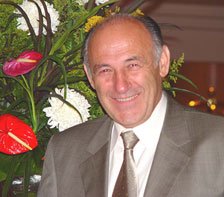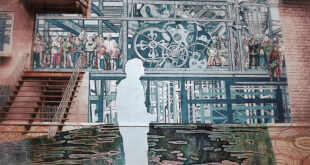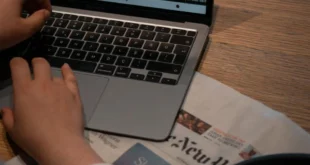
The technology is the result of a partnership between TVZ Ltd - a company with strong links to the television newsgathering business - and Fourth Broadcast Network Ltd. (4BN), specialists in web and internet-based software development, integration and services.
"Stop using Thuraya phones" journalists told
By Chris Forrester
The ability of "embedded" reporters (reporters accompanying Allied forces) to report instantly from the battlefield may be curtailed. Numerous reports on March 30 say that US military commanders in Iraq have banned the use of some satellite phones, in particular those using Thuraya (and this includes Inmarsat's Regional BGAN system) carried by journalists attached to their units, apparently fearing the signal could give away their location to Iraqi forces. Questioned on the new rules, Major-General Victor Renuart told a news briefing at US Central Command in Qatar that the order was not meant to restrict media coverage. Thuraya's location-finding system is accurate to within 100 metres and its location data is downloaded to Thuraya headquarters in Abu Dhabi. Rival Iridium satellite phones have a less accurate location-finding system and the user data is downloaded direct to the United States.
Reprinted with permission from Satcom Insider, Volume 5, Issue 7 (April 1, 2003)
When TVZ cracked the compression problem broadcasters hailed it as the start of "a broadcast revolution" which would end the reliance on expensive satellite transfers, thus saving massive amounts of money, particularly for international news organisations operating bureaux all around the world.
Now, there have been two major developments.
First: both the BBC and ABC News have completed appraisals of the TVZ software and have bought licences to operate it. The BBC has deployed its first 13 purchases (over and above the three they already held for the appraisal exercise) of the "Laptop Newsgathering" (LNG) system during the Gulf war. The software is loaded onto Panasonic Toughbook laptops and used in conjunction with AVID editing software. All 13 units have been despatched to the Middle East where TV correspondents have to be ready to "travel light" on media trips organised by the military. If it proves as efficient and cost effective as they expect, you can bet that all their main offices and any correspondents travelling to remote locations will be carrying similar equipment by the end of the year.
Peter Mayne, Executive Editor BBC Newsgathering said, "The LNG system has been rigorously field tested by BBC correspondents in West Africa and we are satisfied that the system is rugged enough to cope with whatever our newsgathering teams might be faced with in the Gulf. The LNG software integrates well with our editing platform on one laptop - a distinct advantage for teams that need to travel light." The BBC's Steve Pearce confirms that the system is being used currently in Iraq for filmed reports (two-ways still rely on videophone) and is working extremely well: it is, says Pearce, "the best quality store-and-forward system I've seen."
Just a quick reminder of why the customers are so excited. The new compression algorithm enables broadcast quality video to be condensed into a data file that can be transmitted as an email attachment or FTP file at ratios between 1:1.5 or 1:2. In other words, one minute of TV will transmit in anything between a minute and a half and two minutes. It's not real time but it is about seven times faster than the previous best with no loss of quality.
Combined with a software decoder system, a video file can be transmitted via the internet or a satellite phone to the home studios, where it can be decoded for playout without the end-user having to purchase bespoke hardware. Costs over satellite phone are significantly higher than via an office-based internet connection for the simple reason that bandwidth is limited and the cost-per-minute is significantly higher. As Pearce points out, it takes around one hour to transit a 3-minute filmed report by videophone. The benefit of transmitting via sat-phone is independence.
For office/studio based distribution of either news pictures or other programming, the technology presents significant cost advantages over conventional means of distribution.
The cash saving, for a company currently buying ten ad-hoc satellite feeds per week is around $US390,000 per annum. Let's take a local example. One Middle East organisation which is appraising the system right now estimates that its saving could be in the region of $8 million per annum. That is a significant sum in a business (news) which appears not to be able to generate profits unless it is in India!
Just before the invasion, another major broadcaster announced that it is deploying the Laptop News Gathering (LNG) system in the Gulf: the US network, ABC News, has taken 15 LNG software licences which are installed onto laptops.
The second development is that we were wrong in believing that TVZ was leading the field!
It seems that the Russian TV network, RTVI, has already begun using a similar system for regular broadcasts between New York and Moscow, using UUNet.
The announcement that it had started commercial broadcasting over the internet came quite out of the blue in January. The company's press release described it as "an historic event."
RTVI is using software developed by the San Diego, California, company, Path 1 Network Technologies, which has also identified the potential cost savings to customers as the driving force for its research and development.
"For years, we have been watching for true-video-over-IP, and Path 1 appears to be the first company out of the gate and currently provides the best working solution available for sending broadcast quality video over standard IP networks," comments Gerry Kaufhold, principal analyst with In-Stat/MDR.
The system being used by RTVI is not the same as TVZ's and is designed to save money in the delivery to the end users, the viewers, rather than save the ad-hoc satellite fees which are so crippling to the big news organisations.
Details of the system are sketchy but RTVI says they simply connected through Path 1's Cx1000 IP gateway to UUnet and began transmitting. They are sending between 4 and 6 megabits of live video over 12 hops to Moscow. The system transmits in real time via IP in either compressed or uncompressed mode and either from point-to-point or to multiple end-users.
Though different from TVZ's compression software, Cx1000 saves money in the same way - by literally eliminating satellite costs. The return on capital expenditure is almost immediate.
In this Business to Consumer (B2C) environment, quality is the single most important factor. In just the same way as the news organisations want to upgrade their signals sent by correspondents in the field, from the jumpy, grainy sat-phone quality which came to prominence in Afghanistan, to full-on broadcast quality, so the viewer sitting at home needs at least the quality in light entertainment, sports, and movies to which he has become accustomed.
Julius Feinstein, vice president of broadcast operations and engineering for RTVI's parent company, Overseas Media, says the first few days were a revelation, not least because the system worked despite the poor quality of Russia's telecommunications infrastructure. "It is one thing to send video across a US or European backbone but to pass broadcast-quality video across a congested and under-maintained Russian infrastructure is just unbelievable," he said. "We saw no glitches. There's no special provisioning, it just works."
Feinstein says the broadcaster now plans similar links from New York to Tel Aviv and Frankfurt. Because the technology works so well, he says RTVI will be able to concentrate on its core business of providing information to its viewers, rather than technology.
The RTVI experience could herald the next phase of broadcast, which some describe as web streaming. "It shows that the quality barrier has been crossed. This ought to bring in extra viewers (subscribers), extra interactive services and, therefore, new revenue streams," says Feinstein.
 Arab Media & Society The Arab Media Hub
Arab Media & Society The Arab Media Hub




